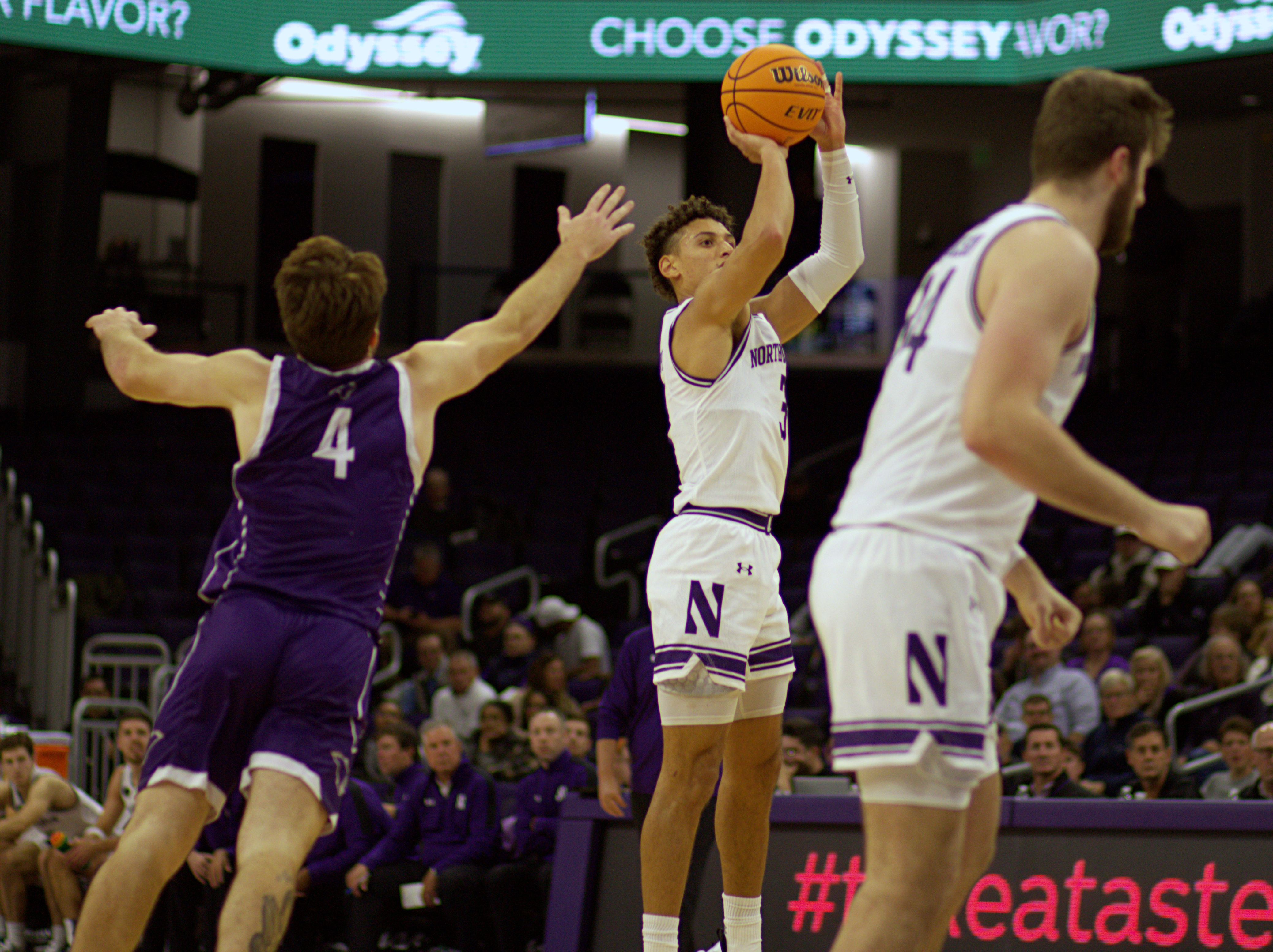
The “Cardiac ’Cats” turn of phrase, in reference to the most anxiety-inducing of Northwestern sporting events, is used easily and often: when the football team loses an early lead but manages to pull out a win, or when the women’s basketball team comes out of the halftime locker room guns a-blazing to turn an opening-half deficit into a tight game.
Of all its varied uses, I find it most aptly applied when men’s basketball is on the verge of victory/defeat, and the combination of the on-court back-and-forth with the uproarious student section is sending my heart rate through the Welsh-Ryan roof.
If there’s one thing Northwestern Men’s Basketball (15-5, 6-3 B1G) knows how to do, it’s win a close game (unless it’s against Chicago State). The most obvious instances are Northwestern’s two overtime wins this season, one over then-#1 Purdue (19-2, 8-2 B1G) and most recently against #10 Illinois (15-5, 6-3 B1G). But examples abound, from a narrow early-season victory over now-#16 Dayton (16-3, 6-1 Atlantic 10) to a nail-biter against Maryland (13-8, 5-5 B1G) that was decided in the final 20 seconds.
TOOK THE LEAD FOR GOOD 👻 pic.twitter.com/6IcEgSqrh9
— Northwestern Basketball (@NUMensBball) January 18, 2024
Northwestern’s success this season, which has earned them the current #4 spot in B1G rankings, is not the result of exceptional offense. The ’Cats sit 11th in the conference in points per game and 10th in scoring margin. However, they have significantly improved their shooting percentage from 40.7% last year, when they ranked last in the conference and 331st in the nation, to 47.4% this year, which puts them sixth in the B1G.
Defensively, Northwestern occupies a similar middle-of-the-pack spot, ranking fifth in the B1G in points allowed and 10th in opponent shooting percentage. The ’Cats struggle on the glass, sitting dead last in team rebounds, likely due to Northwestern’s small size in comparison to other B1G teams. They play four guards in their starting lineup, and although third-year guard Brooks Barnhizer and fourth-year guard Ty Berry pull down an average of 6.6 and four rebounds per game, respectively, it’s tough to compete with double-digit rebounders like Purdue’s fourth-year center Zach Edey and Maryland’s third-year forward Julian Reese.
What they lack in size, however, the ’Cats make up for with quick help defense and the ability to cut off passing lanes, snagging 7.7 steals per game, good for third in the B1G. Northwestern forces an average of 13.7 opponent turnovers per game while committing only 8.9 per game, earning the second-best turnover margin in the conference.
The Steal. The Slam. pic.twitter.com/ipLjaIBM8T
— Northwestern Basketball (@NUMensBball) January 20, 2024
The Wildcats aren’t necessarily outstanding in any category, but they’re good enough. They also have synergy as a team and a roster of experienced players who work well under pressure.
Leading the Wildcats is graduate guard Boo Buie, who has recently jumped into third place on Northwestern’s all-time leading scorers list. Averaging team-highs 18.5 points and 5.3 assists per game, Buie handles the ball with confidence and distributes it with ease. He has been integral to Northwestern’s biggest wins, scoring a season-high 31 points against Purdue and 29 against Illinois.
.@booboo_buie floats his way to 3rd in career points in program history 👻 pic.twitter.com/EaW50sgvQr
— Northwestern Basketball (@NUMensBball) January 28, 2024
Barnhizer, who came off the bench all of last season, has solidified his role on the team. The 6-foot-6 guard’s versatility and strength on both sides of the ball have led him to average a team-high 36.1 minutes per game. He leads the Wildcats in rebounds and racks up an average of two steals per game, good for fourth in the B1G.
An exciting addition to the team this year has been graduate transfer guard Ryan Langborg, who shoots 40% from the three-point stripe and averages 11.5 points. He’s also become something of a fan favorite; when he hits a shot from beyond the arc, the student section chants his name, an honor previously reserved for Buie alone.
Ryan Langborg has 14 first half points 🤖 pic.twitter.com/17pbruLSAh
— Northwestern Basketball (@NUMensBball) January 28, 2024
Rounding out the regular starting lineup are Berry and fourth-year center Matthew Nicholson. Since last year, Berry has transformed from a confident yet somewhat erratic shooter into a major offensive threat, improving his shooting average from 34.2% to 45.8%, and his three-point percentage from 29.1% to 42.5%.
While Nicholson sometimes struggles on offense, he provides much-needed size for the ’Cats on defense and averages 1.4 blocks per game, good for ninth in the conference.
Coming off the bench for the ’Cats are second-year forwards Luke Hunger and Nick Martinelli. Hunger, who sat out much of last year due to injury, has found his way into the regular rotation and even into the starting lineup when he replaced Nicholson for a five-game stint. At 6-foot-10, he adds size and strength to the Wildcats and has a decent three-point shot. Martinelli, who has the size of a forward and the agility of a guard, averages 7.2 points and 3.2 rebounds per game.
🔨🔨🔨pic.twitter.com/qqiWMPdTd7 https://t.co/D4sjInWLBf
— Northwestern Basketball (@NUMensBball) January 18, 2024
This year, the ’Cats are on a mission to make program history with first-ever back-to-back NCAA tournament bids. While the team has dominated at home, picking up a few wins on the road will set Northwestern apart as they continue conference play.
The Wildcats are on track to go far if they can keep pulling out the hard-fought wins. It’s bound to be an exciting – and likely anxiety-inducing – next couple of months of Northwestern basketball.
This feeling never gets old ‼️ pic.twitter.com/16CMJ2Ohrc
— Northwestern Basketball (@NUMensBball) December 2, 2023
Thumbnail photo by AJ Anderson / North by Northwestern